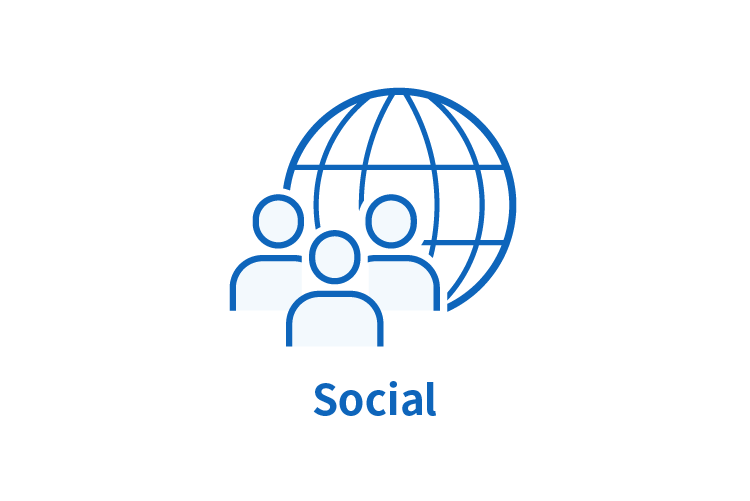Towards the Promotion of Health & Productivity Management
KOKUSAI ELECTRIC CORPORATION has declared the following promotion policy for Health & Productivity Management under its management policy to realize its corporate slogan.
Health & Productivity Management Declaration
In order to realize our corporate slogan, "Creating the future through technology and dialogue," the KOKUSAI ELECTRIC Group will promote the creation of workplaces where each employee can work with enthusiasm and vitality, without worrying about both physical and mental health, based on the unchanging basic principle that "protecting safety and health takes precedence over everything else" in all business activities. We also declare that we will actively work to improve the health of our employees and their families.
July 1, 2025
President and Chief Executive Officer
Kazunori Tsukada
Health & Productivity Management Organizational Structure
We position Health & Productivity Management as one of the important management issues. Under the Health & Productivity Management Declaration by top management, the Executive Officer in charge of Human Resources and General Affairs takes responsibility for promoting health management, including initiatives to solve problems such as physical health, mental health, and creating a rewarding work environment.
The Health & Productivity Management Promotion Committee regularly discusses policies and initiatives related to health measures, and reports to the Board of Directors, Management Committee, and Sustainability Committee. In addition, in collaboration with the health insurance association and the safety and health committee, the committee promotes initiatives while monitoring the status of employee health promotion measures (PDCA).
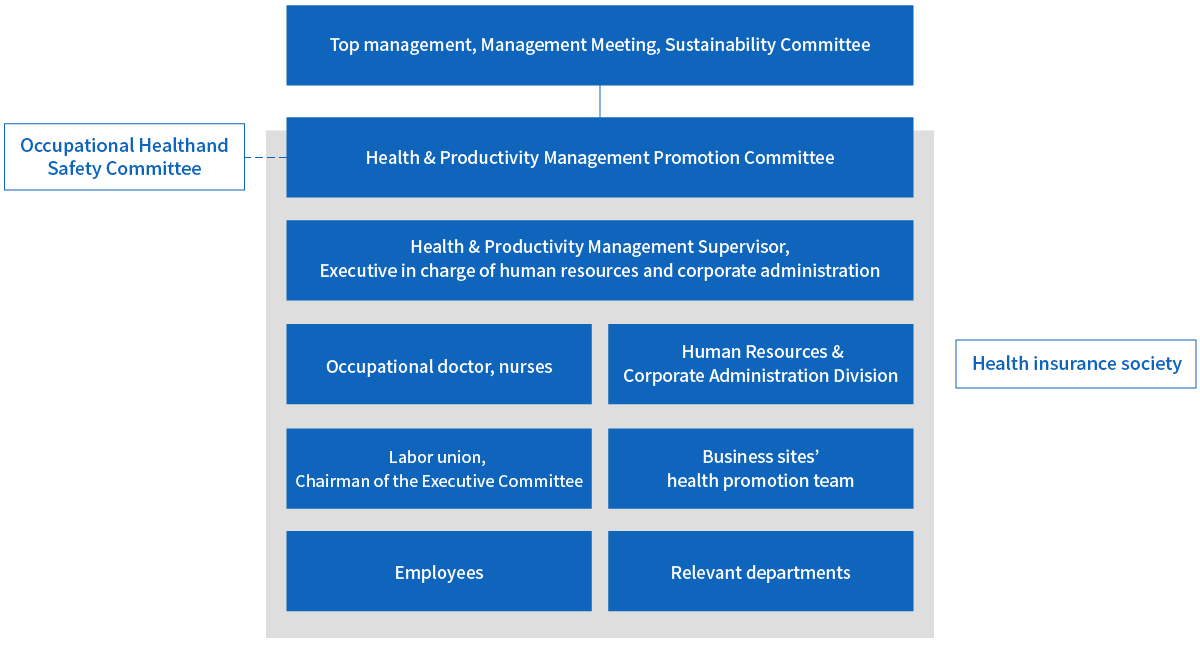
Health & Productivity Management Strategic Map
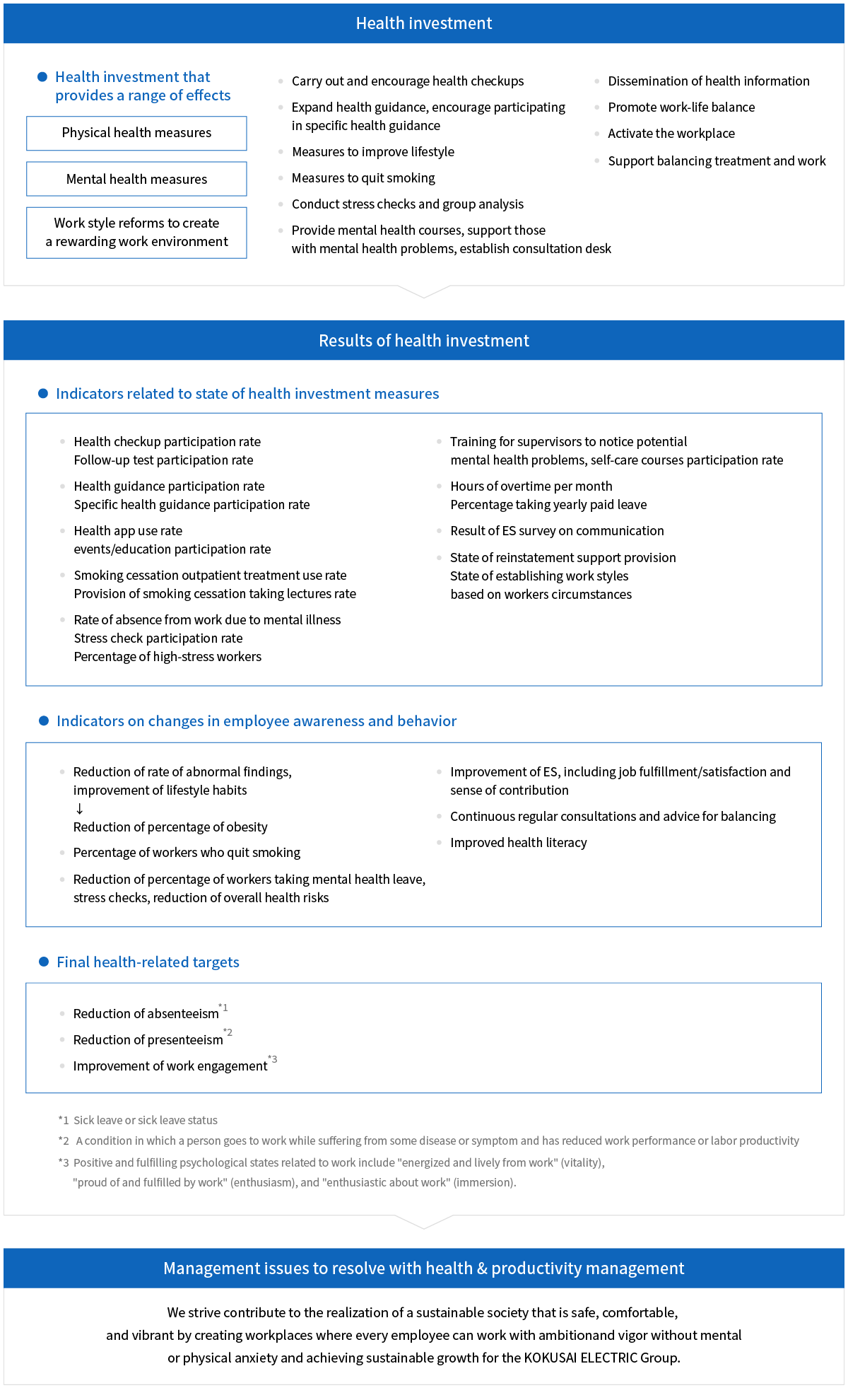
Key Measures
1. Physical health measures
Strengthening preventative measures for those at risk of lifestyle-related diseases
Targets
In order to promote the health of employees, we set reducing “obesity rate (for those 40 and above)” and “smoking cessation rate” as key targets, and carry out the following measures to achieve those targets.
| Category |
2020 |
2021 |
2022 |
Key targets |
|---|---|---|---|---|
| Obesity rate (for those 40 and above) |
37.2% |
36.0% |
35.9% |
30% |
| Smoking cessation rate |
20.6% |
22.3% |
21.8% |
20% |
Health management system
We implemented a health management system, which enables the status of checkup appointments and participation to be shared with managers. Thanks to providing thorough follow up to ensure appointments are kept, we have achieved a 100% participation rate. We also take preventative measures by using the system in health guidance and encouraging employees to take follow-up tests.
We are also enhancing a wide range of health education efforts and strengthening efforts to achieve targets.
Dietary habit event
In fiscal 2022 we launched a new initiative called “Vegetable Check,” where employees get their vegetable intake levels checked and receive advice from a registered dietitian. The event is held regularly, once every three months.
Participation has grown each time. Many who had not been eating enough vegetables have shown improvement by the next Vegetable Check. We will continue to regularly hold the event in an effort to improve dietary habits.
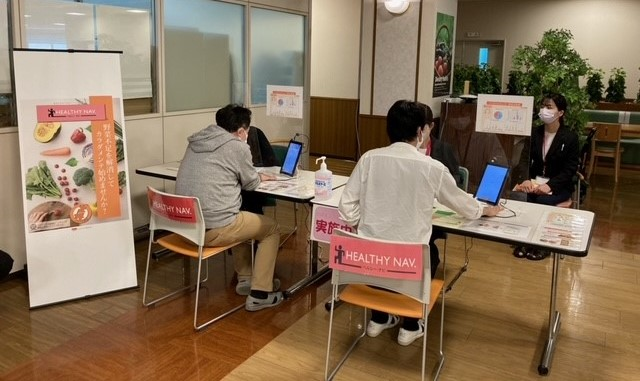
Strengthening efforts to increase low smoking cessation rate
In line with World No-Tobacco Day and No Tobacco Week, we distribute questionnaires on smoking and provide no smoking education to smokers by an occupational doctor.
We are also strengthening efforts to lower the smoking cessation rate, such as providing online quit smoking programs in collaboration with our insurer and offering financial assistance for smoking cessation outpatient treatment.
2. Mental health measures
Targets
In fiscal 2022, KOKUSAI ELECTRIC saw a decrease in overall health risks from stress checks, but a sharp increase in workers taking mental health leave. We are taking the following measures to detect and respond to mental health problems early to ensure they do not become serious.
| Category |
2020 |
2021 |
2022 |
Key targets |
|---|---|---|---|---|
| Percentage of workers taking mental health leave |
0.32% |
0.37% |
0.64% |
0.30% |
| Overall health risk |
106 |
107 |
100 |
99 |
Enhancing efforts to detect and respond to mental health problems early
Making use of stress check group analysis results
Creating an environment that enables workers to take stress checks via the health management system has increased the participation rate.
Based on the stress check group analysis results, we provide feedback to each workplace to improve the workplace environment. When there is a high-stress workplace, we send an occupational doctor to conduct interviews on the circumstances at the workplace and develop and implement an action plan to improve the workplace environment.
Occupational doctor consultations for workers with mental health issues
Regular consultations with an occupational doctor are provided to workers with mental health issues in collaboration with an occupational psychiatrist and nurse. We also utilize treatment handbooks to help those who take mental health leave recover and get back to work without worry.
Enhancing consultation desks
We established an internal consultation desk that employees can contact anytime, where nurses are available to respond and provide follow-up as needed. We also established a health consultation desk with a female occupational health staff (occupational doctors and nurses) to provide support so employees can work without worry.
We are enhancing our consultation system so that employees and their families can use external consultation desks to ensure they can work with peace of mind.
Engaging in efforts to enhance supervisor training on mental health
In an effort to enhance the training of supervisors to notice potential mental health problems in employees, we have been offering training courses by an occupational psychiatrist since fiscal 2022. Consisting of small classes, the course aims to strengthen practical management skills by allowing participants to engage in discussion, talk about their concerns, and ask questions.
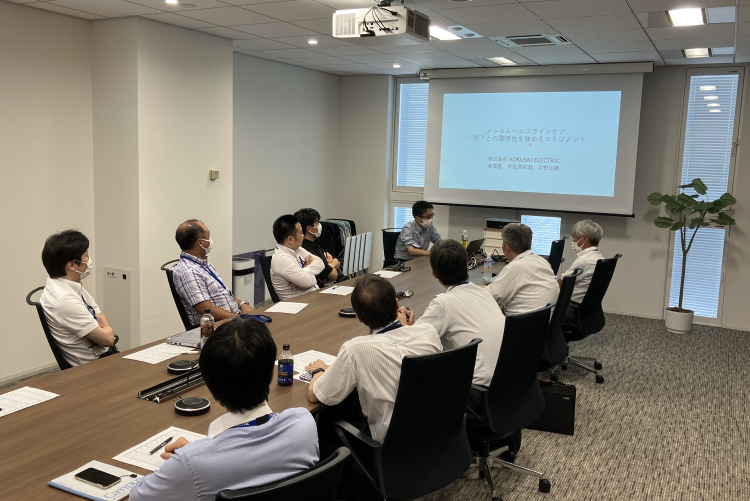
3. Work reforms to create a comfortable workplace
Promoting work-life balance
Activating the workplace
We measure employee satisfaction by category through conducting regular surveys on all Group companies within and outside Japan. Based on the results, we develop and implement action plans to make improvements in each department. We also carry out initiatives to activate the workplace. One example of this is creating opportunities for employees to engage in dialogue company-wide.
Support to balance treatment and work
In order to help employees who have job anxiety or have missed work due to illness or injury, we have implemented measures such as a health consultation desk, an accumulated annual paid leave program workers can use for inpatient and outpatient treatment, a long-term leave compensation program, and regular consultations with an occupational doctor.
When an employee is ready to return to work, they consult with an occupational doctor and are given regular follow-up and support after they have returned.
The long-term leave compensation program allows employees to take up to 36 months off work due to illness or injury. They also receive an illness and injury allowance (for 18 months) from the health insurance society, and treatment compensation from the company for up to 36 months.
Indicators related to health & productivity management efforts
| Category |
2020 |
2021 |
2022 |
|---|---|---|---|
| Regular health checkup participation rate |
99.9% |
100.0% |
100.0% |
| Rate of abnormal findings in regular health checkups |
29.3% |
31.5% |
30.8% |
| Follow-up test participation rate after regular check-up |
54.5% |
61.7% |
58.4% |
| Rate of occupational doctor consultations with high-risk workers*1 |
100.0% |
100.0% |
100.0% |
| Obesity rate (over BM 125) for those 40 years old and above |
37.2% |
36.0% |
35.9% |
| Obesity rate (under BM 125) for those 39 years old and under |
20.8% |
22.6% |
20.9% |
| Smoking cessation rate |
20.6% |
22.3% |
21.9% |
| Percentage of workers who exercise |
19.3% |
21.0% |
21.6% |
| Percentage of people who get enough sleep and rest |
44.6% |
44.4% |
45.1% |
| Stress check participation rate |
91.4% |
92.5% |
97.2% |
| Percentage of high-stress workers based on stress checks |
13.7% |
14.8% |
15.6% |
| Overall health risk |
106 |
107 |
100 |
| No. of workers missing work annually due to mental illness/injury |
5 |
10 |
22 |
| No. of workers missing work annually due to physical illness/injury |
2 |
1 |
8 |
| Absenteeism absence rate (mental)*2 |
0.32% |
0.37% |
0.64% |
| Absenteeism absence rate (physical)*3 |
0.09% |
0.02% |
0.17% |
| Presenteeism*4 |
- |
- |
80% |
| Work engagement*5 |
- |
- |
2.4点 |
| Average continuous years of service |
20.95 |
20.76 |
20.22 |
| Overtime working hours (hrs/month) |
25 |
26.4 |
23.6 |
| Annual days of leave (days/year) |
15.9 |
15.7 |
19 |
| ES survey response rate |
- |
89.9% |
94.6% |
- *1
-
Cases where consultation with occupational doctor is deemed necessary.
- *2
-
Rate of absence from work = number of days of absence from work due to illness / number of scheduled working days x 100 (actual number of days of absence from work due to mental illness is 7 or more consecutive days)
- *3
-
Rate of absence from work = number of days of absence from work due to illness / number of scheduled working days x 100 (actual number of days of absence from work due to physical illness is more than 7 consecutive days)
- *4
-
Based on independent survey: Respondents selected their job performance in the last four weeks from 10% to 100%, with job performance when in normal, good condition being 100%. The figure indicated is the most selected response.
- *5
-
Ascertained from a measure of work engagement based on a simple questionnaire about new job stress
Indicators related to awareness and behavior change (health literacy improvement)
| FY 2022 measures |
Participation rate |
Target |
|---|---|---|
| Health app use rate |
17.5% |
All employees |
| Number of Vegetable Check participants |
72 |
Employees who wish to participate |
| Self-care training participation rate |
97.5% |
All employees |
| Line care training participation rate*1 |
17.2% |
Management |
| Attendance rate of anti-smoking education*2 |
51.8% |
Smokers |
| Percentage of women taking education on women's health issues |
100.0% |
Women |
| Satisfaction with each measure*3 |
80.8% |
All employees |
- *1
-
Implemented for a small number of people since January 2023. We plan to offer to all management in fiscal 2023.
- *2
-
Offered to smokers since fiscal 2022. We plan require all smokers to take it starting in fiscal 2023.
- *3
-
Those who answered "satisfied" or "somewhat satisfied" out of "satisfied," "somewhat satisfied," "not very satisfied," or "dissatisfied."
